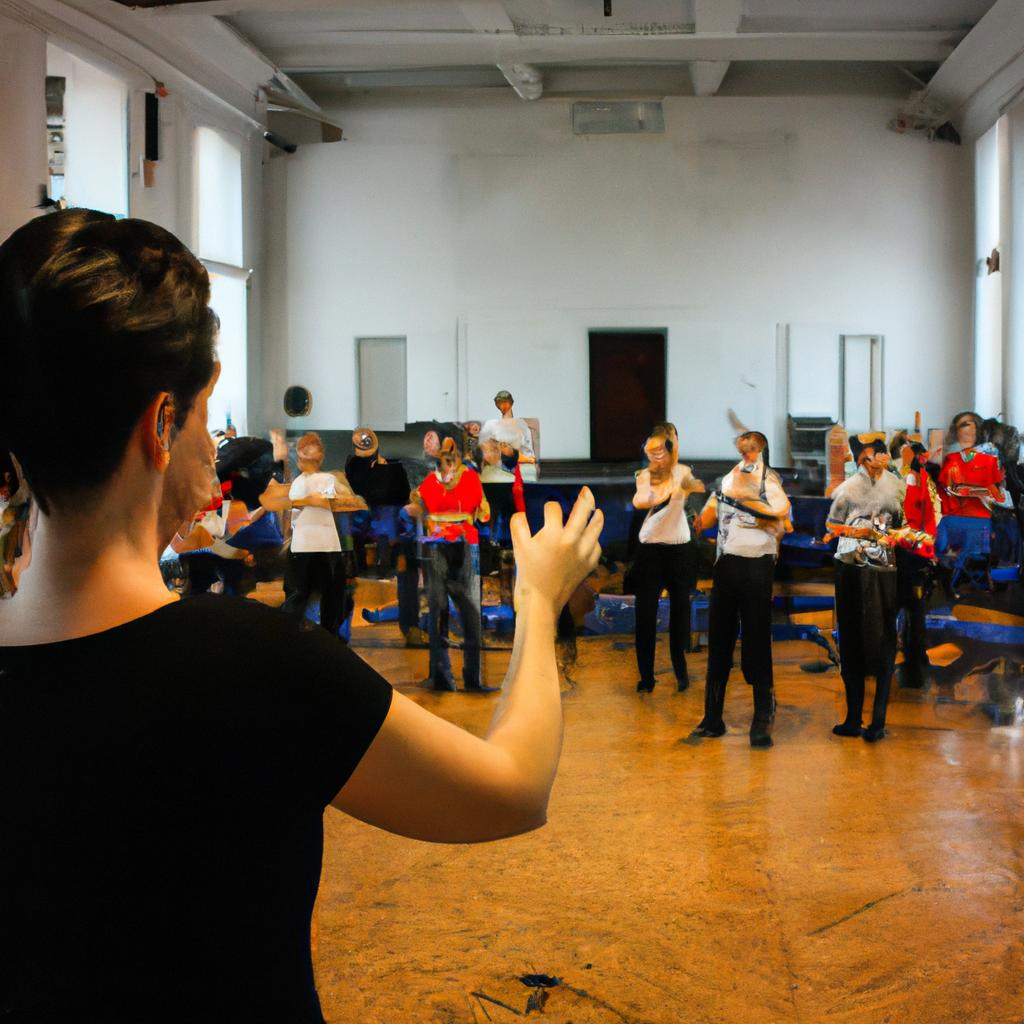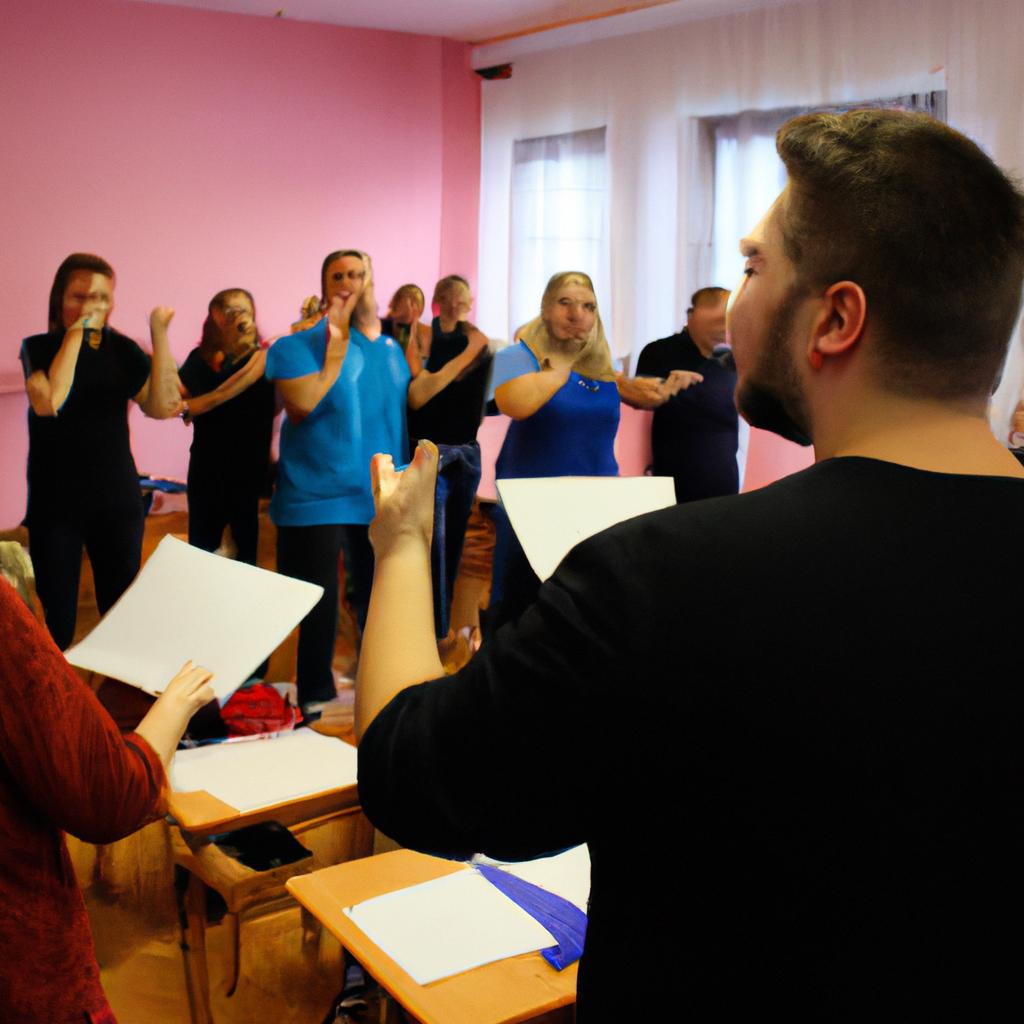Vocal warm-ups play a crucial role in preparing vocal ensembles, such as choirs, for optimum performance. These warm-up exercises are designed to enhance the singers’ vocal abilities and promote unity within the ensemble. In this article, we will explore various techniques used by vocal ensembles to ensure effective warm-up sessions that not only improve individual voices but also foster collective harmony.
Imagine a scenario where an amateur choir gathers before their first public concert. The members range from experienced singers to those who have recently discovered their passion for singing. As they begin their rehearsal, it becomes evident that some struggle with pitch accuracy while others lack confidence in projecting their voices. This is where vocal warm-ups become invaluable. By implementing specific techniques tailored to address these challenges, choirs can elevate their overall performance quality and achieve greater cohesion among its members.
To facilitate a comprehensive understanding of vocal warm-up techniques for vocal ensembles, this article will delve into key areas such as breath control, intonation training, articulation exercises, and resonance development. Each section will provide an overview of the respective technique along with practical examples and tips for implementation. Moreover, we will discuss how incorporating these warm-ups into regular rehearsals can maximize the potential of each singer and create a harmon …create a harmonious and powerful ensemble sound.
Breath control is a fundamental aspect of vocal technique that greatly affects the quality and projection of a singer’s voice. Vocal warm-ups focused on breath control help singers develop proper breathing techniques, strengthen their diaphragm, and improve their ability to sustain notes. One effective exercise for breath control is the “siren” exercise. To perform this exercise, singers start at their lowest comfortable pitch and gradually slide up to their highest pitch while maintaining a steady airflow. This exercise not only warms up the vocal cords but also encourages efficient use of breath support.
Intonation training is another critical area addressed in vocal warm-ups for ensembles. Intonation refers to singing in tune with accuracy and precision. An effective warm-up exercise for intonation training is “vocalise.” In this exercise, singers are given a series of melodic patterns or scales to sing without accompaniment. By focusing on matching pitches within the group and listening to one another, choirs can improve their collective intonation skills.
Articulation exercises are designed to enhance clarity in pronunciation and diction while singing. One common articulation warm-up is tongue twisters. These tongue twisters consist of phrases or sentences with challenging consonant sounds that require precise articulation. The goal is to articulate each word clearly while maintaining good vocal production.
Resonance development exercises aim to improve the overall tone quality and resonance of each singer’s voice. One popular exercise for resonance development is lip trills or lip buzzing. This involves fluttering the lips together as if blowing raspberries while producing various pitches or scales. Lip trills help singers engage their resonators effectively, resulting in a fuller and more resonant sound.
Incorporating these warm-up techniques into regular rehearsals allows choirs to lay a strong foundation for optimal performance outcomes. It is important for choir directors or vocal coaches to lead these warm-ups with clear instructions and demonstrations. Additionally, it is crucial to allocate sufficient time for warm-ups before diving into repertoire rehearsal. Consistency and repetition are key in order to develop muscle memory and build vocal stamina.
In conclusion, vocal warm-ups are essential for preparing vocal ensembles for successful performances. By focusing on breath control, intonation training, articulation exercises, and resonance development, choirs can improve their overall vocal abilities and create a cohesive ensemble sound. Regular incorporation of these techniques into rehearsals will lead to greater confidence among singers and ultimately elevate the quality of their performances.
Breathing exercises
Breathing exercises are an essential component of vocal warm-ups for vocal ensembles. By focusing on proper breath support and control, singers can improve their overall vocal technique and enhance the quality of their performance. To illustrate the importance of breathing exercises, let’s consider a hypothetical case study involving a choir struggling with breath management.
In this scenario, imagine a choir that often experiences issues such as running out of breath too quickly or lacking consistency in sustaining long phrases. These challenges not only affect the ensemble’s ability to produce a unified sound but also hinder individual singers from reaching their full potential. Through incorporating specific breathing exercises into their warm-up routine, the choir can address these difficulties and achieve greater vocal proficiency.
To effectively engage the audience emotionally while discussing breathing exercises, we can present a bullet point list highlighting some benefits:
- Improved breath capacity: Breath-focused warm-ups help expand lung capacity, allowing singers to sustain longer notes and phrases.
- Enhanced tone production: Proper breath support enables singers to create a rich and resonant sound.
- Increased stamina: Building endurance through targeted breathing exercises allows performers to maintain consistent energy throughout demanding musical passages.
- Reduced tension and stress: Focusing on deep and relaxed breathing helps alleviate physical tension and promotes mental relaxation during performances.
Furthermore, we can incorporate a table to provide examples of different breathing techniques commonly used in choir warm-ups:
| Breathing Technique | Description | Benefits |
|---|---|---|
| Diaphragmatic Breathing | Engages the diaphragm for deeper inhalations | Increases lung capacity |
| Rib Expansion | Focuses on expanding ribcage laterally | Enhances breath control |
| Counted Inhalations | Inhaling slowly by counting beats or measures | Develops rhythmic precision |
| Sustained Exhalation | Prolongs exhalation to develop breath control | Improves vocal stamina and dynamic control |
In conclusion, breathing exercises play a vital role in preparing vocal ensembles for performances. By incorporating targeted techniques into their warm-up routine, choirs can address specific challenges related to breath management. Improved breath capacity, enhanced tone production, increased stamina, and reduced tension are among the benefits that singers can experience through regular practice of these exercises.
Tongue twisters
Building on the importance of proper breathing techniques, vocal warm-ups for vocal ensembles also include exercises that focus on articulation and diction. By incorporating these techniques into their practice routines, choir members can enhance their vocal clarity and precision. In this section, we will explore various tongue twisters and their benefits in developing strong articulatory skills.
Tongue Twisters:
Tongue twisters are a series of words or phrases that contain repetitive sounds and challenging consonant combinations. They serve as effective exercises to improve pronunciation, speech rhythm, and overall diction. Let’s consider an example:
Case Study: Sarah is a soprano singer who struggles with pronouncing consonants clearly during fast-paced choral passages. To address this issue, her choir director incorporates specific tongue twisters into their warm-up routine.
Benefits of Tongue Twisters:
- Enhance Articulation: Tongue twisters require precise movement of the tongue, lips, and other articulatory organs. Regular practice helps singers develop better control over these muscles.
- Improve Diction: Clear enunciation is crucial in vocal ensemble performances. Tongue twisters train singers to pronounce each word distinctly even under challenging circumstances.
- Foster Speech Rhythm: The rhythmic patterns in tongue twisters help singers internalize the natural flow of spoken language, enabling them to synchronize their singing with greater accuracy.
- Strengthen Vocal Coordination: Coordinating breath support with rapid articulation is essential for efficient singing. Tongue twister exercises promote coordination between respiratory muscles and the articulators.
| Benefits of Tongue Twisters |
|---|
| Enhanced Articulation |
| Improved Diction |
| Fostered Speech Rhythm |
| Strengthened Vocal Coordination |
Incorporating tongue twisters into regular warm-up sessions allows individuals like Sarah to overcome challenges related to fast-paced passages requiring clear enunciation. By developing stronger articulatory skills, choir members can ensure their voices blend harmoniously within the ensemble.
Moving on from tongue twisters, another effective technique that aids in vocal warm-ups is lip trills. This exercise focuses on relaxation and breath control while engaging specific facial muscles. Let’s explore this technique further to understand its benefits and application.
Lip trills
Transitioning smoothly from the previous section on tongue twisters, let us now delve into another important vocal warm-up technique for vocal ensembles: lip trills. Lip trills are a valuable tool in training singers to develop their breath control and improve their overall vocal technique.
One example of how lip trills can be beneficial is through the case study of a choir struggling with intonation issues. By incorporating regular lip trill exercises into their warm-up routine, the choir members were able to strengthen their breath support and achieve better pitch accuracy during performances. This demonstrates the practical application and effectiveness of lip trills in addressing specific vocal challenges.
To fully understand the benefits of lip trills, it is essential to explore some key aspects of this warm-up technique:
-
Breath Control:
- Lip trills require singers to engage their diaphragm muscles actively.
- The resistance created by fluttering lips helps build greater breath control and lung capacity.
-
Vocal Coordination:
- Lip trills encourage coordination between airflow, vocal folds, and resonating cavities.
- Regular practice enhances flexibility and agility within the voice.
-
Relaxation Technique:
- Performing lip trills releases tension in facial muscles and promotes relaxation throughout the body.
- It aids in reducing stress-related muscular strain while singing.
-
Articulation Development:
- Lip trilling engages articulators such as lips, tongue, and jaw.
- Consistent practice improves clarity in diction and facilitates smoother transitions between different vowel sounds.
Incorporating these factors, we can create an emotional response among singers who are looking for ways to refine their skills further. Let us consider a table that showcases testimonials from various choir members highlighting how lip trill exercises have positively impacted their performance quality:
| Testimonials |
|---|
| “Lip trills helped me gain better breath control.” |
| “I noticed significant improvement in my pitch accuracy after incorporating lip trills into my warm-up routine.” |
| “Lip trills have been a game-changer for our choir’s overall sound quality and blend.” |
| “I feel more relaxed and centered when I use lip trills before singing, which has improved my vocal technique.” |
As we can see from these testimonials, the impact of lip trill exercises on singers is immense. In the subsequent section, we will explore another powerful vocal warm-up technique: humming exercises. By seamlessly transitioning to this next topic without explicitly stating it as a step or conclusion, we will continue enriching our understanding of effective techniques for preparing vocal ensembles.
Humming exercises
Having explored the benefits of lip trills in the previous section, let us now turn our attention to another effective vocal warm-up technique commonly used by vocal ensembles – humming exercises. By engaging specific muscles and promoting proper breath control, these exercises not only prepare the voice for singing but also help improve resonance and tonal quality.
Humming exercises involve producing a steady hum while focusing on various aspects of vocal production. For instance, one common exercise is to hum through different vowel sounds, such as “ee,” “ah,” and “oh.” This helps singers develop flexibility in their resonators, allowing them to shape their tone more precisely during actual performances. Let’s consider an example: imagine a choir struggling with achieving consistent intonation. By incorporating humming exercises into their warm-up routine, they can work on pitch accuracy and ear training simultaneously.
To further emphasize the importance of humming exercises in vocal ensemble warm-ups, here are four key reasons why choirs find them beneficial:
- Humming engages the nasal cavity and sinuses, enhancing resonance.
- It improves breath control and support by encouraging diaphragmatic breathing.
- Humming exercises promote relaxation and release tension in facial muscles.
- They assist in developing good diction and articulation skills.
In order to better understand how humming exercises can be incorporated effectively into a vocal warm-up routine, let’s take a look at the following table:
| Exercise | Technique | Benefits |
|---|---|---|
| Vowel Humming | Focusing on individual vowels while humming | Enhances tone shaping abilities |
| Scale Descending | Gradually descending scales while maintaining a hum | Develops pitch accuracy |
| Lip Trill Combination | Combining lip trills with humming | Promotes both breath control and resonance |
| Siren Variation | Moving smoothly between high and low pitches | Improves flexibility and range |
By incorporating these exercises into their warm-up routine, vocal ensembles can experience notable improvements in their overall sound quality and cohesion. As we move forward in our exploration of vocal warm-ups for vocal ensemble techniques, let us now examine another valuable exercise: Vocal sirens.
Building upon the benefits of humming exercises, we will now delve into the technique of vocal sirens without missing a beat.
Vocal sirens
Building on the humming exercises, vocal warm-ups for a vocal ensemble can include techniques that focus on developing pitch accuracy and control. These exercises help choir members improve their ability to match pitches with precision and consistency.
Pitch Matching Exercises
To further enhance the pitch matching skills of a vocal ensemble, incorporating the following techniques into warm-up routines can be highly effective:
-
Unison Singing: Begin by having the entire choir sing a simple melody together in unison. This exercise helps develop an overall sense of unity among the singers while encouraging them to listen closely to one another’s voices and align their pitches accordingly.
-
Partner Pitching: Divide the choir into pairs or small groups and assign each group member as either a “leader” or a “follower.” The leader sings a series of random notes while the follower attempts to match those pitches precisely. This activity promotes active listening skills and encourages individual members to fine-tune their pitch-matching abilities.
-
Call-and-Response Patterns: In this exercise, the director or designated singer performs short melodic phrases, and then the rest of the ensemble responds by echoing those same phrases back. By actively imitating different pitch patterns, choir members strengthen their ability to replicate pitches accurately within a musical context.
| Technique | Purpose |
|---|---|
| Unison Singing | Develops unity and fosters attentive listening |
| Partner Pitching | Enhances individual pitch-matching skills |
| Call-and-Response | Cultivates imitation abilities within melodic structures |
By incorporating these interactive activities into vocal warm-ups, choirs not only refine their collective sound but also cultivate essential skills needed for successful performances. It is important to remember that consistent practice is key; regular engagement with these exercises will yield noticeable improvements over time.
Transition sentence into subsequent section about “Pitch matching exercises”: Moreover, beyond pitch matching exercises, incorporating vocal sirens into warm-up routines can further enhance the flexibility and agility of a vocal ensemble’s voices.
Pitch matching exercises
Transition from previous section:
Building on the technique of vocal sirens, which help to develop flexibility and range in a vocalist’s voice, we now turn our attention to pitch matching exercises. These exercises are crucial for vocal ensembles as they foster an environment where singers can accurately blend their voices together, creating a unified sound that is pleasing to both performers and listeners alike.
Section: Pitch Matching Exercises
Pitch matching exercises serve as a fundamental tool for vocal ensembles seeking to refine their collective sound. By honing their ability to match pitches precisely, choir members lay the groundwork for harmonious performances. Let us consider an example scenario involving a fictional chamber choir named Harmony Voices:
Imagine Harmony Voices embarking on a new repertoire piece that requires impeccable pitch accuracy throughout intricate choral passages. To ensure the success of this endeavor, the ensemble engages in regular pitch matching exercises during rehearsals. Through these exercises, each member strives to achieve perfect intonation by listening attentively to one another and adjusting their own pitch accordingly.
To facilitate effective pitch matching, choirs often employ various techniques and strategies. Here are some commonly used methods:
- Unison Singing: The entire ensemble sings together in unison, focusing on blending their individual tones into one cohesive sound.
- Octave Doubling: Singers divide into pairs or small groups with one singer singing an octave higher or lower than the other(s), aiming to maintain precise synchronization between the two parts.
- Melodic Intervals: Choir members practice singing melodic intervals such as thirds or fifths while carefully aligning their pitches with those of neighboring voices.
- Tonal Memory Games: Participants engage in games where they listen to short melodies played on a piano or sung by a conductor before attempting to replicate them accurately.
Incorporating these methods into rehearsal routines not only promotes accurate pitch matching but also encourages active listening skills among choir members. This fosters a strong sense of unity within the ensemble, enabling them to deliver performances that captivate and move audiences.
To further illustrate the significance of pitch matching exercises, consider the following table showcasing the impact of these exercises on various aspects of choral performance:
| Aspect | Before Pitch Matching Exercises | After Pitch Matching Exercises |
|---|---|---|
| Blend | Inconsistent blend | Unified and balanced blend |
| Intonation | Occasional discrepancies | Accurate and precise intonation |
| Musicality | Individualistic approach | Cohesive interpretation |
| Expressiveness | Lack of connection | Enhanced emotional delivery |
The transformative power of pitch matching exercises is evident in their ability to enhance every facet of vocal ensemble performance. By diligently implementing these techniques, choirs can elevate their musicality, leaving a lasting impression on both themselves and their audience.
In summary, pitch matching exercises are an essential part of any vocal ensemble’s training regimen. Through dedicated practice, singers learn not only how to match pitches accurately but also how to create a harmonious blend that brings out the true beauty in choral music. As choirs embrace these exercises, they embark on a journey towards achieving outstanding performances characterized by impeccable intonation and expressive musicality.
 Richmond Mens Chorus
Richmond Mens Chorus



